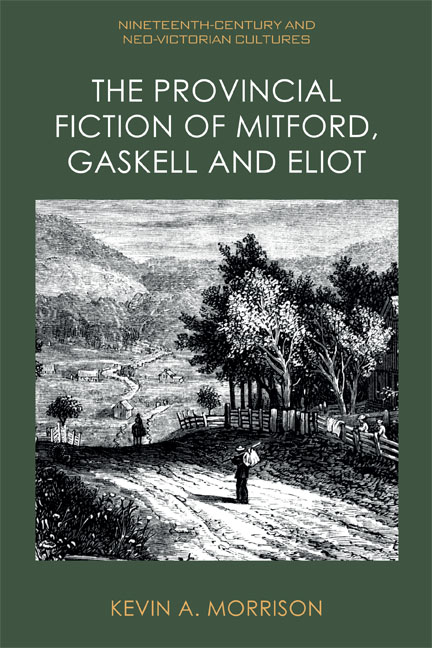Book contents
- Frontmatter
- Contents
- List of Illustrations
- Acknowledgements
- Series Preface
- Introduction: The Politics of Provincial Fiction
- 1 Sketches of Rural Character: Mary Russell Mitford’s ‘Fugitive Pieces’
- 2 Sketches of Rural Scenery: Mitford’s Country Rambles
- 3 From Sketches to Papers: Gaskell’s Country Village
- 4 Landscape-Shaped Subjectivity: George Eliot’s ‘Mother Tongue’
- 5 A Wider Horizon: Portable Interiority and Provincial Life
- Conclusion
- Bibliography
- Index
4 - Landscape-Shaped Subjectivity: George Eliot’s ‘Mother Tongue’
Published online by Cambridge University Press: 05 March 2025
- Frontmatter
- Contents
- List of Illustrations
- Acknowledgements
- Series Preface
- Introduction: The Politics of Provincial Fiction
- 1 Sketches of Rural Character: Mary Russell Mitford’s ‘Fugitive Pieces’
- 2 Sketches of Rural Scenery: Mitford’s Country Rambles
- 3 From Sketches to Papers: Gaskell’s Country Village
- 4 Landscape-Shaped Subjectivity: George Eliot’s ‘Mother Tongue’
- 5 A Wider Horizon: Portable Interiority and Provincial Life
- Conclusion
- Bibliography
- Index
Summary
In 1902, Macmillan relaunched its celebrated English Men of Letters series under the general editorship of John Morley. With the release of Leslie Stephen's George Eliot, the publisher inaugurated its second series – which, following convention, retained the male noun as universal – with a study of a woman writer. Remarking on Eliot's turn to fiction after a number of years as an essayist, Stephen notes that her decision to write the village tales that make up Scenes of Clerical Life (1857) had a precedent in, among other works, Mary Russell Mitford's Our Village and Elizabeth Gaskell's Cranford (1853). For Stephen, however, this is where the comparison with her near contemporaries ended. While all three authors, he contends, wrote about the people and places they knew well, Eliot possessed ‘a profoundly reflective intellect, which contemplates the little dramas performed by commonplace people as part of the wider tragi-comedy of human life; and the village communities, their thoughts and customs, as subordinate elements in the great “social organism”’ (1902: 62).
Although her library included a single volume of Our Village at the time an inventory was taken and George Eliot surely thought of Mitford as one of the authors for whom she felt ‘vague gratitude’ for having ‘charmed’ her in the past, she records no specific impressions of her predecessor. Nevertheless, Eliot's attention to the topographical details of St Ogg’s, the fictional village in The Mill on the Floss, bears Mitford's traces. In ‘The Queen of the Meadow’, which appeared in the 1827 annual the Literary Souvenir and was published in the third volume of Our Village the following year, Mitford's narrator recalls traversing a ‘winding unfrequented road’ that leads to ‘a low, two-arched bridge, thrown across a stream of more beauty than consequence’. Just across it stands ‘a small irregular dwelling, and the picturesque buildings of Hatherford Mill’. ‘It was a pretty scene on a summer afternoon, was that old mill’, the narrator continues, ‘with its strong lights and shadows, its low-browed cottage covered with the clustering Pyracantha, and the clear brook which after dashing, and foaming, and brawling, and playing off all the airs of a mountain river, while pent up in the mill-stream, was no sooner let loose, than it subsided into its natural peaceful character, and crept quietly along the valley, meandering through the green woody meadows.’
- Type
- Chapter
- Information
- The Provincial Fiction of Mitford, Gaskell and Eliot , pp. 171 - 222Publisher: Edinburgh University PressPrint publication year: 2023

